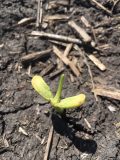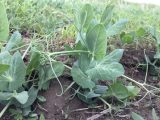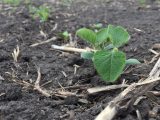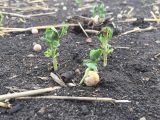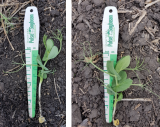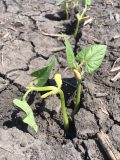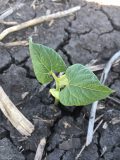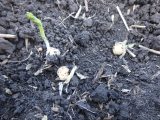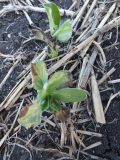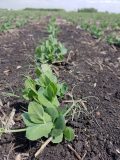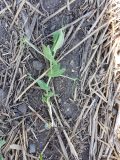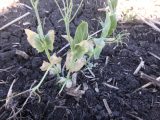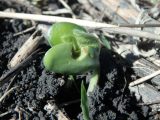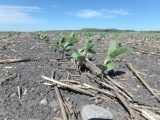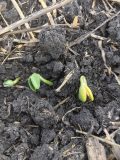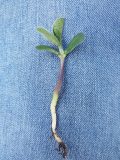June 10, 2020
- Crop Staging and Conditions
- Late Soybean Planting
- Assessing Pulse and Soybean Plant Stands
- Early Season Insect and Disease Scouting
- Soybean POST Herbicide Options
Listen to the Bean Report here:
Crop Staging
- Soybeans and dry beans are mainly at the VE to VC stage across the province. The earliest seeded soybeans and dry beans have reached V1.
- With a wide range in planting dates this year, field peas are anywhere from V4-V7 (4-7 node). This means several fields are nearing or have surpassed V6 (6-node), which is a critical time for herbicide application in peas. Many of the in-crop herbicides cannot be applied past the V6 stage. Remember to exclude the two scale nodes at the base of the plant from the total true node number. Check out this video for a walk-through on staging peas.
- Faba beans currently range from V2 to V4.
- Growth staging guides for pulse and soybean crops are available here. Scouting calendars are available for soybeans, field peas and dry beans – these are timelines that indicate when to scout for insect and disease pests, and their impact on production and quality.
Crop Conditions
- Last week we saw a lot of soil crusting and seedlings struggling to emerge. These seedlings had either yellow plant tissue and swollen or crooked stems from trying to grow around soil clods. Rain should help alleviate soil crusting issues.
- Some pea, soybean and faba bean fields were touched by the frost on May 30. These plants had discoloured or brown, crispy plant tissue. Overall, pulse and soybean crops weren’t hit as hard by frost as other crops.
- There were concerns over the heavy winds last week. If you suspect wind damage, assess plant stand and crop conditions this week. You may see a loss of plant stand, abrasion to plants or a pinched stem from being spun around by the wind. Some crops have been reseeded due to wind dama
 ge.
ge. - Emergence of weeds was slow in many fields up until late last week due to dry conditions. With the recent rain, major flushes of weeds will likely appear this week.
- Some fields have been sprayed for cutworms. Continue to monitor cutworm damage, taking note of any regrowth in pea and faba bean crops.
- Manitoba Agriculture and Resource Development’s weekly crop report is available here. Current weather conditions and reports are available here.
Late Soybean Planting
When spring planting is delayed in Manitoba, can early maturing soybeans achieve acceptable yields and reach maturity before fall frost? Research conducted by Agronomist-In-Residence, Kristen MacMillan, has tested this. Long story short—it depends on where you’re located in the province. Read the full story here.
Plant Stand Assessment
Assessing plant stand each year is an important tool for estimating seed survival for future seeding rates. Determine the number of live plants per acre to compare with your seeding rate.
MPSG’s Bean App Plant Stand Assessor tool is available to calculate plant populations:
- Use the fixed area method for crops planted in 7 – 14” rows or the row length method for crops planted in 15 – 30” rows.
- Enter your hoop diameter, area of square or length of row measured and the number of plants in that area.
- Assess multiple spots throughout the field and let the tool calculate plants/acre for you.
- App feedback is specific to soybeans, but the calculator itself can be a useful too for other crops.
Higher plant populations could mean increased yield potential, but also a greater risk of disease pressure. Lower plant populations mean more attention should be paid towards weed control. If populations are so low you’re considering replanting or topping up soybean stands, read this post to help make soybean replanting decisions.
Scouting for early season insects and diseases
Keep an eye out for early-season pest pressure, investigating patchy emergence and plant damage.
Insects to look for:
- Continue to monitor for cutworms over the next week or two.
- Scout fields that are slow to emerge and areas with wilted, yellow or missing plants.
- Dig around damaged plants within the top 10 cm of soil to find cutworms. They move deeper in the soil during the heat of the day. It may be easier to spot them under cool conditions or in the evening when they feed.
- Identify the species and size of cutworms – dingy, redbacked and darksided are most common. While some cutworm species stop feeding as they get larger, others will feed more as they get to the larger stages.
- Nominal thresholds:
- Soybeans and dry beans: 1 or more cutworms (<2 cm in length) per metre of row, or 20% of plants cut
- Peas and faba beans: 2-3 cutworms (<2 cm long) per square metre
- Pea leaf weevils – New to western MB last year, keep an eye out for this pest of peas and faba beans. Adult weevil feeding appears as leaf notching.
- Wireworms – Assess crops from planting until V3. Dig into the soil to assess damage to underground parts of young seedlings.
- Seedcorn maggot – an infrequent pest with no established economic thresholds. Cut open suspect seedling stems.
Diseases to look for:
- Root rots in all pulses caused by Fusarium, Rhizoctonia and Pythium
- Phytophthora sojae in soybeans
- Aphanomyces in peas
Submit plant samples to Manitoba Agriculture and Resource Development Crop Diagnostic Centre or one of the labs listed on the linked CDC webpage.
Prevention strategies for next year include fungicide seed treatments, crop rotation and use of soybean varieties with genetic resistance to Phytophthora. Practices that improve overall plant vigour – like early planting dates, well-drained fields, disease-free seed and adequate crop nutrition can be used to reduce the impact of root rot.
Soybean Post-Emergent Herbicide Options
On-Farm Network Update
Most On-Farm Network trials established at spring seeding time have been implemented. In addition to pea and dry bean fertility, and dry bean tillage management, trials were established to address several soybean management questions. These include investigating population, row spacing, seed treatment and inoculation practices.
We are also beginning to test more biological products in soybean – there are a multitude of biological products on the market, for application at seeding or midseason, claiming to do any number of things from protecting plants to increasing nutrient availability – the question is, do they work? The On-Farm Network creates an opportunity for unbiased testing of these products. Have a product you’ve heard about and may want to test on your farm? Let us know! Contact Megan Bourns, On-Farm Network Agronomist, at 204-751-0439 or megan@manitobapulse.ca.



